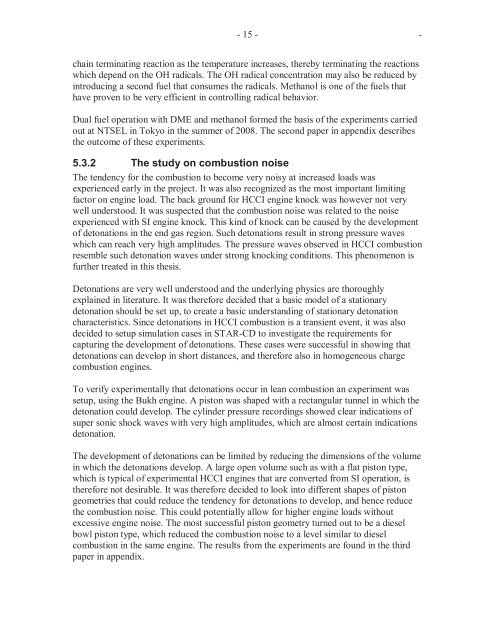Troels Dyhr Pedersen.indd - Solid Mechanics
Troels Dyhr Pedersen.indd - Solid Mechanics
Troels Dyhr Pedersen.indd - Solid Mechanics
Create successful ePaper yourself
Turn your PDF publications into a flip-book with our unique Google optimized e-Paper software.
- 15 - -<br />
chain terminating reaction as the temperature increases, thereby terminating the reactions<br />
which depend on the OH radicals. The OH radical concentration may also be reduced by<br />
introducing a second fuel that consumes the radicals. Methanol is one of the fuels that<br />
have proven to be very efficient in controlling radical behavior.<br />
Dual fuel operation with DME and methanol formed the basis of the experiments carried<br />
out at NTSEL in Tokyo in the summer of 2008. The second paper in appendix describes<br />
the outcome of these experiments.<br />
5.3.2 The study on combustion noise<br />
The tendency for the combustion to become very noisy at increased loads was<br />
experienced early in the project. It was also recognized as the most important limiting<br />
factor on engine load. The back ground for HCCI engine knock was however not very<br />
well understood. It was suspected that the combustion noise was related to the noise<br />
experienced with SI engine knock. This kind of knock can be caused by the development<br />
of detonations in the end gas region. Such detonations result in strong pressure waves<br />
which can reach very high amplitudes. The pressure waves observed in HCCI combustion<br />
resemble such detonation waves under strong knocking conditions. This phenomenon is<br />
further treated in this thesis.<br />
Detonations are very well understood and the underlying physics are thoroughly<br />
explained in literature. It was therefore decided that a basic model of a stationary<br />
detonation should be set up, to create a basic understanding of stationary detonation<br />
characteristics. Since detonations in HCCI combustion is a transient event, it was also<br />
decided to setup simulation cases in STAR-CD to investigate the requirements for<br />
capturing the development of detonations. These cases were successful in showing that<br />
detonations can develop in short distances, and therefore also in homogeneous charge<br />
combustion engines.<br />
To verify experimentally that detonations occur in lean combustion an experiment was<br />
setup, using the Bukh engine. A piston was shaped with a rectangular tunnel in which the<br />
detonation could develop. The cylinder pressure recordings showed clear indications of<br />
super sonic shock waves with very high amplitudes, which are almost certain indications<br />
detonation.<br />
The development of detonations can be limited by reducing the dimensions of the volume<br />
in which the detonations develop. A large open volume such as with a flat piston type,<br />
which is typical of experimental HCCI engines that are converted from SI operation, is<br />
therefore not desirable. It was therefore decided to look into different shapes of piston<br />
geometries that could reduce the tendency for detonations to develop, and hence reduce<br />
the combustion noise. This could potentially allow for higher engine loads without<br />
excessive engine noise. The most successful piston geometry turned out to be a diesel<br />
bowl piston type, which reduced the combustion noise to a level similar to diesel<br />
combustion in the same engine. The results from the experiments are found in the third<br />
paper in appendix.

















